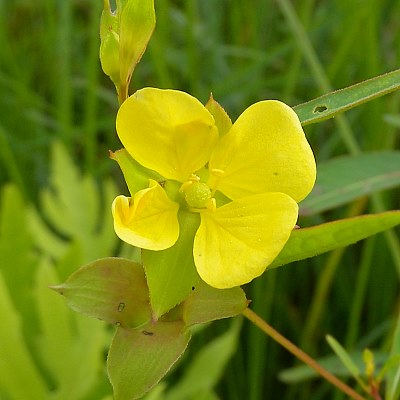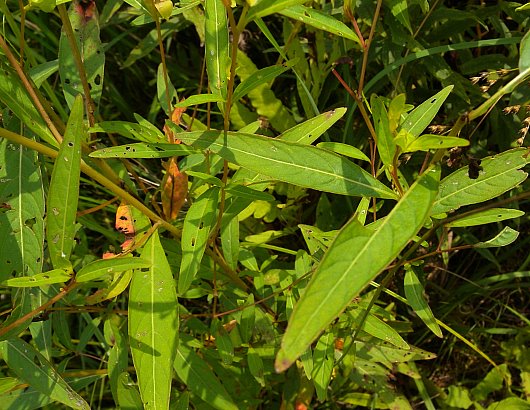
Along the upper half of each plant, solitary flowers develop from the axils of the leaves on short pedicels (about 1/8" in length). Each flower is ½-¾" across, consisting of 4 yellow petals, 4 light green sepals, 4 short stamens, and a pistil with a short style. The tip of the style is light green and globular. The petals are oval to obovate in shape, while the sepals are ovate-cordate in shape; both petals and sepals are about the same length. The sepals are glabrous and smooth along their margins; sometimes their margins are slightly ciliate or tinted red. The blooming period occurs during the summer for about 2 months. Each flower remains intact for only a single day; the petals are early-deciduous and
Cultivation: The preference is full to partial sun, wet to moist conditions, and an acidic sandy soil, although other soil types are tolerated.
Range & Habitat: The native Seedbox is occasional in most areas of Illinois, except in parts of central and northern Illinois, where it is either uncommon, rare, or absent. Habitats include openings in floodplain woodlands, sandy swamps, acidic gravelly seeps, low areas along streams and ponds, wet prairies, wet sand prairies, and roadside ditches. The pubescent variety of Seedbox, Ludwigia alternifolia pubescens, occurs in southern Illinois, where it is uncommon.
Faunal Associations: According to Robertson (1929), the flowers of Seedbox are visited primarily by bees, including Halictid bees (Augochlorella spp., Halictus spp., & Lasioglossum spp.) and leaf-cutting bees (Megachile spp.); the bees suck nectar or collect pollen from the flowers. Less common floral visitors include Sphecid wasps, small butterflies, beetles, and other insects. Some insects also feed on the foliage and other parts of Seedbox. These species include the leaf beetle Colaspis suggona, the flea beetle Altica litigata, and caterpillars of the moth Eudryas unio (Pearly Wood Nymph). White-Tailed Deer occasionally browse on the foliage during the summer.
Photographic Location: Edge of a sandy swamp at the Heron Boardwalk in Vermilion County, Illinois.

Comments: Seedbox has showier flowers than most Ludwigia spp., and its cubic seed capsules have a distinct appearance. As a result, it is fairly easily to identify when either the flowers or seed capsules are present. Species in this genus are usually found in wetlands. Species in a related genus of the Evening Primrose family, Epilobium spp. (Willow-Herbs), have similar foliage and prefer similar habitats. They can be distinguished from Ludwigia spp. by their narrowly cylindrical seedpods and the presence of tufts of hair on their seeds.